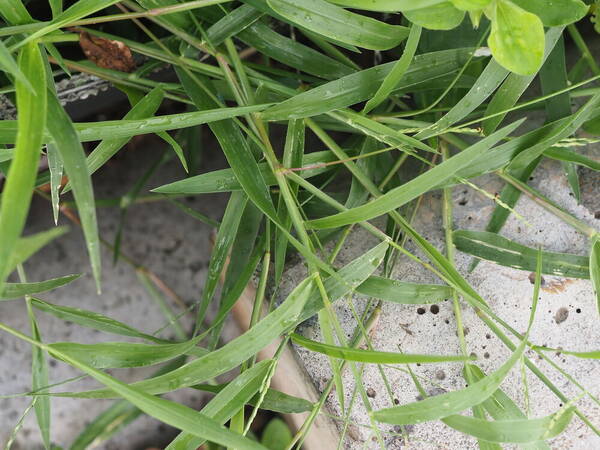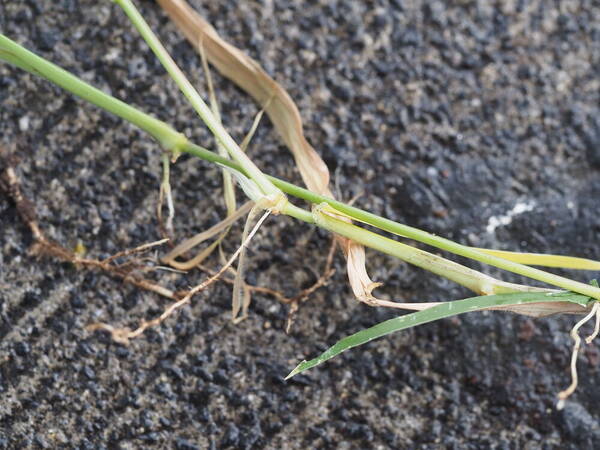Info
Subfamily: Panicoideae
Genus etymology: Urochloa = "tail grass" [Greek] refering to the small tail (mucro) of the upper lemma of some species
Species etymology: distachyos = "twice spike"
Photosynthetic type: C4 (warm season)
Nativity: naturalized - accidental
First recorded in Hawaiʻi: 1938
Map


Inflorescence








Plant






Habit



Spikelets





Node

Collar


Description
Creeping annual; culms 5–20 cm. high, ascending from a prostrate base. Leaf-blades broadly linear to narrowly lanceolate, 2–8 cm. long, 3–7 mm. wide. Inflorescence of 2–3 racemes on an axis 0.5–2 cm. long; racemes 1–3 cm. long, bearing the spikelets on a narrowly winged rhachis. Spikelets narrowly elliptic, 2.4–3 mm. long, glabrous, acute; lower glume 1/3–1/2 as long as the spikelet, clasping; upper glume separated from the lower by a short internode; upper lemma rugulose, bluntly acute.
(Description source: Clayton, W.D. & Renvoize, S.A. 1982. Flora of Tropical East Africa. Gramineae (Part 3). A.A. Balkema, Rotterdam. 448 pp. )
Creeping annual; culms 10–50 cm. high, ascending from a prostrate base. Leaf-blades broadly linear to narrowly lanceolate, 2–20 cm. long, 5–10 mm. wide. Inflorescence of 3–5 racemes on an axis 3–10 cm. long; racemes 2–6 cm. long, bearing the spikelets singly on a narrowly winged rhachis. Spikelets narrowly elliptic, 3.3–3.7 mm. long, glabrous, acute; lower glume 1/3–1/2 as long as the spikelet, clasping; upper glume separated from the lower by a short internode; upper lemma rugulose, bluntly acute.
(Description source: Clayton, W.D. & Renvoize, S.A. 1982. Flora of Tropical East Africa. Gramineae (Part 3). A.A. Balkema, Rotterdam. 448 pp. )
Habit: Annual; mat forming. Culms prostrate; 5-20 cm long. Ligule a fringe of hairs. Leaf-blades linear, or lanceolate; 2-8 cm long; 3-7 mm wide. Inflorescences: Inflorescence composed of racemes. Racemes 2-3; borne along a central axis; unilateral; 1-3 cm long. Central inflorescence axis 0.5-2 cm long. Rhachis narrowly winged; glabrous on margins. Spikelet packing adaxial; regular; 2 -rowed. Spikelets solitary. Fertile spikelets sessile. Spikelets: Spikelets comprising 1 basal sterile florets; 1 fertile florets; without rhachilla extension. Spikelets elliptic; dorsally compressed; compressed slightly; acute; 2.4-3 mm long; falling entire. Rhachilla internodes elongated between glumes. Fertile Spikelets: Spikelets comprising 1 basal sterile florets; 1 fertile florets; without rhachilla extension. Spikelets elliptic; dorsally compressed; compressed slightly; acute; 2.4-3 mm long; falling entire. Rhachilla internodes elongated between glumes. Glumes: Glumes dissimilar; reaching apex of florets; thinner than fertile lemma. Lower glume ovate; clasping; 0.33-0.5 length of spikelet; membranous; without keels; 5-7 -veined. Lower glume apex obtuse. Upper glume oblong; 1 length of spikelet; membranous; without keels; 5-7 -veined. Upper glume apex acute. Florets: Basal sterile florets barren; with palea. Lemma of lower sterile floret similar to upper glume; oblong; 1 length of spikelet; membranous; 5 -veined; acute. Fertile lemma elliptic; 2-2.5 mm long; indurate; without keel. Lemma surface rugulose. Lemma margins involute. Lemma apex acute. Palea involute; indurate; without keels. Palea surface rugose. Distribution: Africa: east tropical and western Indian ocean. Asia-tropical: India, Indo-China, Malesia, and Papuasia. Australasia: Australia. Pacific: southwestern, south-central, northwestern, and north-central.
(Description source: Clayton, W.D., Vorontsova, M.S., Harman, K.T. and Williamson, H. (2006 onwards). GrassBase - The Online World Grass Flora. Available at https://powo.science.kew.org )